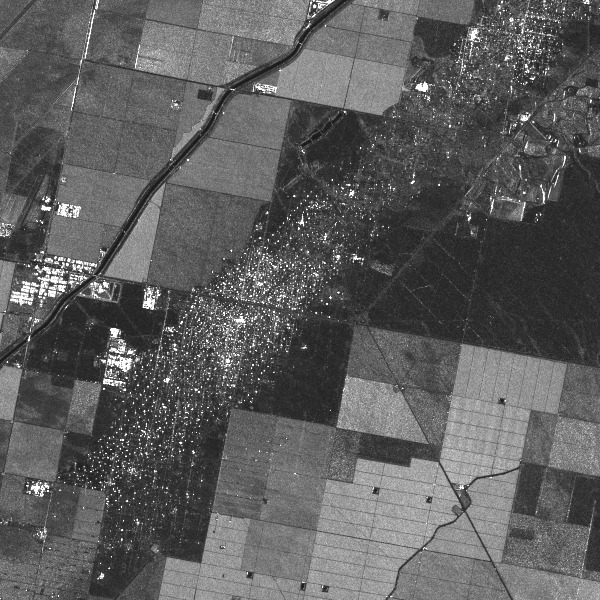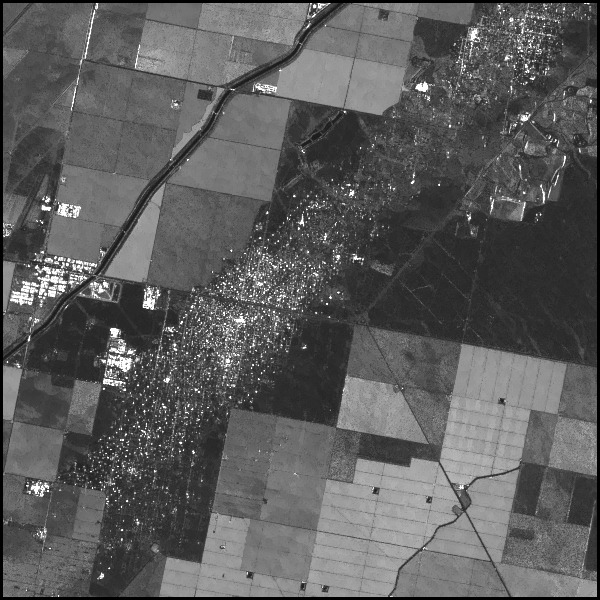Gamma LAT: Reference Manual
mt_lee_filt
ANSI-C program: mt_lee_filt.c
NAME
mt_lee_filt: Multi-temporal Lee directional adaptive speckle
filter
SYNOPSIS
mt_lee_filt <im_list> <ref_image>
<width> <winsz> <L_ref> <L>
<cthres> <out_list> [ref_out] [b_coeff] [filt_num]
[msr] [ctr]
| <im_list> |
(input) text file with names of co-registered float
format images including path (enter - for none)
|
<ref_image>
|
(input) reference image
used to generate the filter weights
NOTE: the reference scene should have the same dimensions
as the data files in the im_list\n");
|
| <width> |
number of samples in each line
|
<winsz>
|
size of the Lee filter
window (valid values: 7, 13, 19)
|
| <L_ref> |
effective number of looks (ENL) in the reference image
(float) |
<L>
|
ENL of the images in the
im_list used for local determination of the the MMSE weight
for each image in the im_list (float)
NOTE: enter - to use the MMSE filter weight derived from
the reference image for all images in the im_list
|
| <cthres> |
directional contrast threshold to determine if the
directional filter should be applied (0->4)(enter - for
default: 1.500)
NOTE: setting cthres=0.0, forces the directional filter to
be used at all times, setting cthres=4.0 blocks all
directional filtering |
| <out_list> |
list of filtered output data files, number of entries
in the im_list and out_list must match, (enter - for
none) |
[ref_out]
|
(output) filtered
reference image (float) (enter - for none)
|
| [b_coeff] |
(output) MMSE weighting coefficient calculated from the
mean to sigma ratio and L for each sample (float) (enter -
for none)
|
[filt_num]
|
(output) selected structural filter number (0-->7)
(byte) (enter - for none)
|
[msr]
|
(output) mean/sigma ratio
where the mean is the local mean and sigma the local
standard deviation of the intensity image in the
filter window (enter - for none)
|
Examples:
mt_lee_filt rmli_list lh_ave.rmli 600 7 100 20 1.5
rmli_lee_list lh_ave_lee.rmli lh_ave_lee.bcf lh_ave_lee.fn
lh_ave_lee.msr
Filter the scenes listed in the rmli_list using filter coefficients
and directional filter number derived from the averaged scene
lh_ave.rmli. For each
file in the input list there is a corresponding output file for
the filtered data listed in the rmli_lee_list. The filtered image of
the reference scene is written to the file lh_ave_lee.rmli. The filter
coefficients are written to the file lh_ave_lee.bcf and the integer
valued filter number (0--> 7) is written to the file
lh_ave_lee.fn. The
mean/sigma ratio for each point in the reference scene is written
to the file lh_ave_lee.msr.
mt_lee_filt
- lh_ave.rmli 600 7 100 - 1.5 lh_ave_lee.rmli lh_ave_lee.bcf
lh_ave_lee.fn lh_ave_lee.msr
Same as above, but there are no files filtered, other than the
reference image itself. The output files are optional.
Description
mt_lee_filt is based on an algorithm
for speckle reduction described in [1] by J.S. Lee et al. This
adaptive filter uses a set of 8 edge aligned window functions to
select the homogeneous area associated with a particular pixel.
The algorithm determines the window that best describes the
region that a particular pixel belongs to. The deviation of
center pixel relative to the average value over the selected
window is used to determine a filter weighting factor that blends
the local signal value with the average calculated using the
window function. If the current pixel deviates strongly from the
average of any edge aligned window function, very little or no
filtering is applied. The algorithm determines both the best edge
aligned filter and the weighting function. There are 8 edge
aligned filters in 4 groups that are tested. The size of the
window is either 7x7, 13x13 or 19x19 samples and the window
functions are:
- top half, bottom half
- left side, right-side
- upper right triangle, lower left triangle
- upper left triangle, lower right triangle
The window function is either 1 or 0. Those samples where
the window function is 1, are averaged in the window, while those
set to 0 are ignored. The filter output is a linear combination
of the local value at position x,y in the reference image and the
average over the filter window. The filter has the advantage that
it is effective in preserving rapid variations in backscatter,
yet strongly filtering speckle noise in homogeneous regions. The
user can write out the filtered reference scene, the weighting
coefficient beta, the index of the selected filter window, and
the mean to sigma ratio as 32-bit float computers.
The user can set a threshold for accepting the directional
filtering operation based on a contrast threshold. The better the
fit of the data to directional filter, the higher the
contrast.
For regions with directional contrast exceeding the threshold,
the directional filtering is applied, otherwise pixels from the
entire region are considered. The value of the contrast varies
between 0 and 4.0. If cthres is set to 0.0, then the directional
filter is always applied. If the value is cthres is set to 4.0,
then there will be no directional filtering.
An feature of mt_lee_filt is that the filter
weight and index of the selected filter window are used to filter
other scenes. Typically the reference scene used to compute the
weighting coefficient and filter window is a multi-look sum and
is very reliable. The other scenes are stored in a list. If there
is a list of input data files, then there must be a list of the
output file names provided by the user. The filter coefficients
and the edge aligned filter number are then used to filter the
entire stack of scenes. The user has the option to
save the weighting factor, edge-aligned filter number, and the
mean/sigma ratio.
An example of a the filter in action, we use a multi-look image
of the Lost-Hills oil field in California. The scene pixel sample
spacing is about 15 meters in range and azimuth. The reference
image is an average of 24 scenes, with each of the 24 scenes
containing 5 look pixels. However the images have relatively high
interferometric correlation. In this example the effective number
of looks parameter L is set to 48 and the window size to 7.
In the case of a homogeneous region, the number of samples in the
spatial average generated by this filter is approximately 24. The
original and filtered images are shown below. Note that the
filter preserves resolution while filtering homogeneous
regions.
Unfiltered reference image of Lost-Hills Oil Field. 24 images
were averaged to produce this multi-look
intensity image
Filtered
reference image of Lost-Hills Oil Field. 24 images were
averaged to produce this multi-look
intensity image. A
7x7 filter window was used. The effective number of looks
parameter L=48.
[1] Lee, J. S., S. Cloude, K. Papathanasslou, M. Grunes, I.
Woodhouse, "Speckle Filtering and Coherence Estimation of
Polarimetric SAR Interferometry Data for Forest Applications,"
IEEE Transactions Geoscience
and Remote Sensing, vol. 41, no. 10, pp 2254-2263,
October, 2003.
[2] Lee, J. S., Eric Pottier, "Polarimetric Radar Imaging: from
Basics to Applications," Chapter 5, CRC Press, Boca Raton,
2008
SEE ALSO
temp_filt, multi_stat, mt_lee_filt_cpx
© Copyrights for Documentation, Users Guide and Reference Manual by Gamma Remote Sensing, 2013.
CW, last change 19-Aug-2013.


